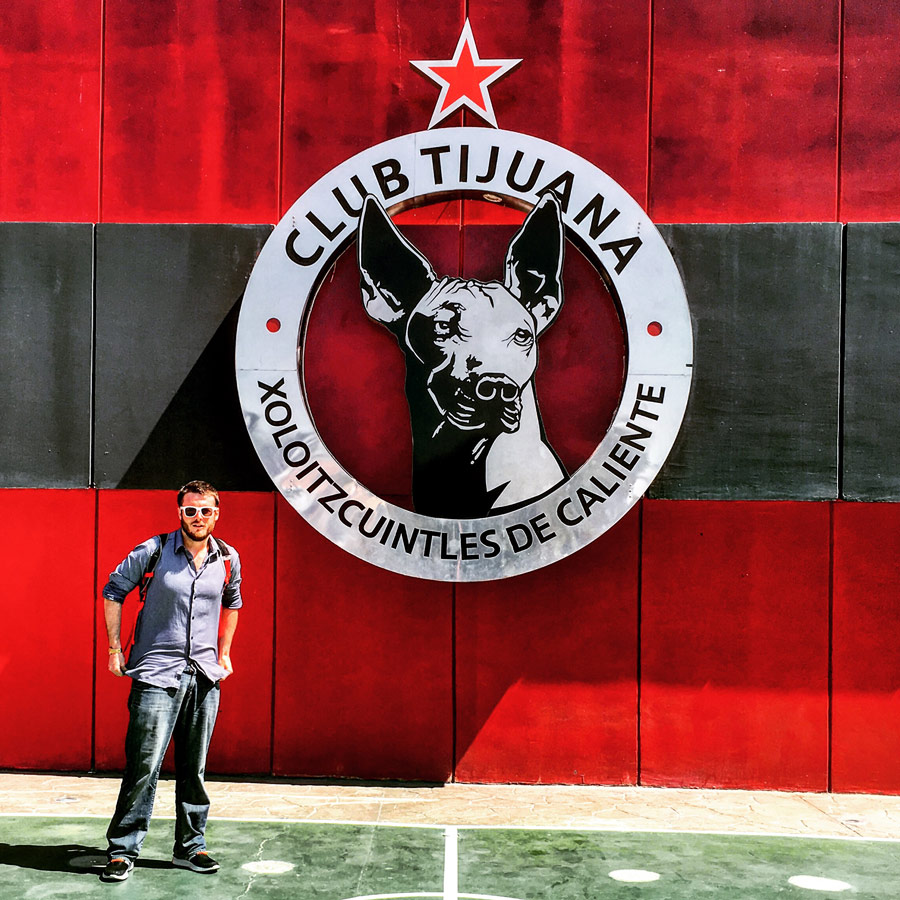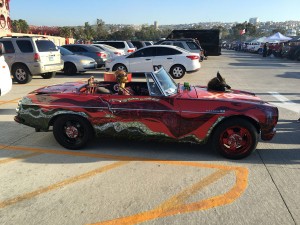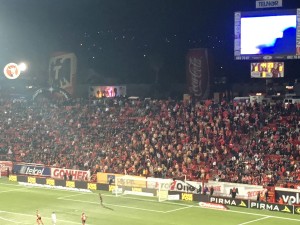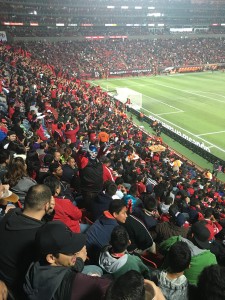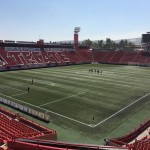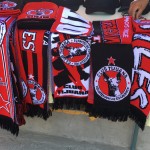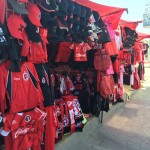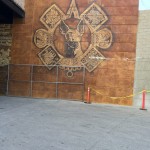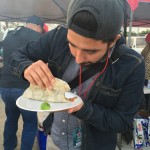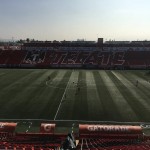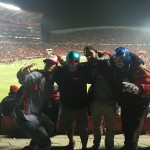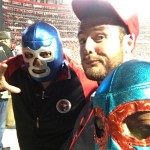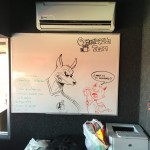What is a home team? A home team is a reflection of your culture. A home team is a reflection of you. It belongs to you. In Tijuana, there exist
What is a home team?
A home team is a reflection of your culture. A home team is a reflection of you. It belongs to you.
In Tijuana, there exists one of the most unusual “home teams” in all the sporting world. Club Tijuana, Los Xoloitzcuintles, a soccer club named after the sacred Mexican dog and affectionately referred to as Xolos by thousands of loyal fans, call Estadio Caliente their home. The club was founded in 2007, and rose to the top-tier of Mexican soccer in 2011. Xolos shocked the competition when they won their first Liga MX championship in the 2012 Apertura, in just their fifth year of existence.
There are lots of things that make Xolos special, but perhaps none more so than their supporters, more specifically the places from which their supporters come. With Estadio Caliente positioned just two miles across the California-Mexico border, it is estimated by club officials that over 8,000 fans per-game in a stadium that seats just over 27,000 are coming from towns in the United States.
Can a team from another country still be your “home” team? Xolos serve as an obvious answer to that question, and their existence represents an interesting concept in a time when nationalism and xenophobia are at the forefront of our advancement (or perhaps regression) as a society. Despite their history being so short, they have already cemented themselves as a truly Mexican-American team.
I wanted to learn more about this club, the fans, and of course these thousands of “Xolos Americanos”. On Friday, I was blessed with the opportunity to do so. Xolos were due to kick off against Toluca at 8:30 on Friday night, but the match itself was to be a small part of a much larger picture.
We left San Diego at 8 am, yours truly and ESPN FC writer Cesar Hernandez being driven by Xolos media guru Jonny Rico. Jonny himself is a fine example of the Xolos culture, commuting across the border for every match and training session that he covers.
After a chilaquile breakfast in Chula Vista, we reached the border. It was my first time ever crossing into Mexico. As I looked out on armed guards and nervous looking drivers, I felt goosebumps on my skin, surely a mixture of excitement and uncertainty.
We finally entered the Mexican side after a brief hold up, having been selected at random for a full vehicle search. We made our way straight to Estadio Caliente, and as we parked, I complimented Jonny on his incredible driving skills, easily dealing with the chaos that is a Tijuana traffic jam.
“When you’re driving in the jungle,” Jonny said, “you better be an animal. Otherwise you ain’t gonna make it out.”
The stadium is a beautiful and innovative structure that has been continually revamped as the Xolos brand continues to rise. Club owner and former Tijuana Mayor, Jorge Hank Rhon, has poured millions into the team and the stadium, and from an aesthetic point of view, he and his crew have done an incredible job.
Large paintings and sculptures of Xoloitzcuintles and various other Aztec imagery are displayed almost everywhere you look, creating this almost sacred kingdom feel when you enter the stadium. The massive Caliente Casino, a dog racing track, and a substantial private zoo (complete with monkeys, zebras, tigers, and bears) surround the venue, adding to the other worldly feel. 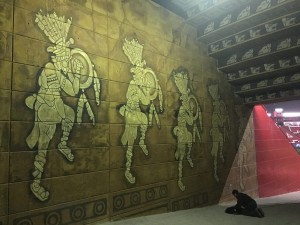
What made this experience so bizarre is how at one moment I’d feel like I was on another planet, then minutes later, it just felt like I was a few minutes away from San Diego. Tijuana was doing this dance on me, constantly switching between a city in a foreign country and simply a neighboring town.
As Jonny went to work, Cesar and I wandered around the stadium, and watched most of the Segunda Division match between Xolos and Santos Laguna. It was a dire affair, with Santos scoring late and winning 1-0.
For much of that morning game, my eyes were roaming from the turf pitch below (the only one in the Mexican top flight) and the dusty brown hills and brightly colored homes that were visible in almost every direction. From many of these homes, you can see California. I can only imagine what that must be like for a child to grow up seeing a place off in the distance, everyday, and being told that he or she is not allowed to go there without special privilege. What kind of feelings could that induce? Jealousy? Animosity? Resentment? Hate? Love and adoration? A desire to one day step foot in the forbidden zone?
The clock struck noon. It was time to go explore the city.
The first stop was the mall next door to the stadium. The sight of a Wal-Mart, an Applebees, a Panda Express, and a Little Caesars had me ready to leave immediately. We continued walking about a mile towards the south end of the neighborhood, and the American chain businesses grew fewer and fewer until there were no more.
With our bellies yelling at us, we found a tiny hole in the wall called La Batalla. We were offered up the Friday special, three gordas de chorizo y papas con lechuga, cebolla, chile, y crema, arroz, frijoles, a big cup of tortilla soup, and a large guava juice, all for 65 pesos, just under $4 American.
We continued our exploration, venturing down side streets, weaving through traffic, and getting our Baja legs underneath us. Car horns and excessively loud radio advertisements blend with the wind and the voices of fellow humans. It was a beautiful day, with temperatures in the mid 70’s, and a mild breeze blowing in from the Pacific.
After an on foot excursion that lasted well over three hours, we found our way back to the Caliente Casino, and enjoyed some cold refreshments in the shade next to the race track. We could see the parking lot at the stadium begin to fill up, and we knew it was time to check out the scene.
This is where this whole day really starts to get interesting. This is where the Mexican-American qualities truly start to shine.
As soon as we stepped foot in the parking lot, I noticed two young kids playing catch with a Nerf football. As soon as they saw me, a big tall white boy, they threw me the ball. I looked around and saw barbecues being lit up, with the aromas of carne asada and chicken wings filling the air. If I didn’t know any better, I would have thought I was at an American college football game.
I struck up a conversation with a muscular and facial tattooed ticket scalper who introduced himself as “Rojo”.
“I’ve been all around Mexico, man. I’ve been to hundreds of soccer games. And this is the only spot I’ve ever seen that does it like this. It’s like it’s half Mexican, half American. It’s Tijuana!”
Rojo told me he was born and raised in El Centro, just on the other side of the border.
“I grew up supporting Chivas, but how the hell am I supposed to get to Guadalajara and back overnight? This place is heaven, man. It’s only a few miles from my house. It belongs to me.”
As we meandered through the lot, the temperature dropped substantially, as a thick gray cloud cover rolled in, creating an almost eery lighting, an angry sun trying desperately to crash the party to no avail.
The next interaction fit the mold of the ones prior. We noticed one of the largest tailgates in the whole lot, complete with three tents (all black, red, and white, but only two of them with Xolos logos, the other decorated with tributes to the San Diego State Aztecs,) two barbecues cooking asada and nopales, a beer pong table in full use, and reggae music blasting, alternating with the banda groups taking requests and playing songs while moving around the parking lot.
The King of this tailgate was Rodrigo, a large man with a big black and gray beard. He spoke to us about what this club and this atmosphere meant to him personally.
” I’m from San Diego, and I live in Chula Vista. I’ve grown up loving soccer. But I also love American football. Aztecs games and Chargers games… those are my kind of parties! I love to tailgate, and Caliente is the only place in Mexican soccer where tailgating and barbecuing in the parking lot is a common thing. It’s very American, but the people of Tijuana embrace what the fans from the other side of the border bring to these games. It’s beautiful to see cultures come together. We are all Xolos here!”
As I scarfed down one of the most delicious asada tacos from Chef Rodrigo, I thought briefly about the situation with the NFL’s San Diego Chargers most likely leaving the city within the next year. I’m fairly certain this has been on the minds of Xolos ownership, as well as 28 year-old Club President Jorge Alberto Hank. The Chargers leaving San Diego could open up yet another door for Xolos, giving people like Rodrigo a place to enjoy their favorite parking lot pastime.
No more than thirty yards away, I spotted my next interaction, but I was about to be in for a pretty humorous surprise.
Surrounded by barbecues and banda music was a group of eight gentlemen, one of which had incredibly light skin. I assumed he was a gringo, a Xolos fan with blond hair and blue eyes. I approached their gathering and asked him what Xolos meant to him.
The Friday match was against Toluca, a club with the same color scheme as Xolos. As soon as I asked this question, the whole group started laughing. It was at this moment that the man opened up his jacket, revealing a red Toluca jersey.
“I still got much love for Xolos,” said the gringo. “Obviously all my friends are Xolos fans. I’ve just loved Toluca since I was a kid. And I like this place. There’s not too many like it, where you can be a fan of an opposing team and not have to worry about it too much.”
These boys were as generous as any, and insisted on feeding me and Cesar. (Cesar and I quietly and delicately debated which tailgate had given us the best asada tacos. It was one of those great arguments where there was really no wrong choice.)
As the banda continued to blare all around us, I noticed a van with a big decal sticker reading “PUMAS Y XOLOS”, with the logo of U.N.A.M. Pumas intertwined with the Xoloitzcuintli.
It’s not as if the 27,000 people there on Friday night discovered soccer in 2008. We have all cherished and embraced the game for most, if not all of our lives. We have all supported other teams, and many of the fans in attendance at Estadio Caliente still root for the clubs they grew up loving long before Xolos existed. But the people of Northern Baja and Southern California have adopted Xolos as their own, because geography and cultural identity are two of the most powerful things in sports.
Night fell. The time had come to enter the stadium.
After socializing with gorgeous female fans, Cesar and I met an older man named Augustine, who seemed just as enamored with our story as we were with the one he had to tell. What Auggie (as he preferred to be called) said to us brought a gigantic smile to my face, and warmed my heart for hours to follow.
“I was born and raised in Tijuana, and I moved to the United States to find work when I was 18. That border is a strange thing. I look around this place, and I see people like you and people like me. We are all one. There is no difference between us, regardless of which side we call home.
I am a roofer in San Ysidro. I have built my life there. I have a beautiful wife and kids. I’ve had family for years that has begged me to come back to Baja and visit. I always told them no. I never wanted to come back. Then Xolos started. Xolos gave me a reason to come back.
I always dreamed of Tijuana having a team. I grew up an Atlas fan, and used to go all the way to Guadalajara to watch them play. I still love the Zoros and always will, but Tijuana is where I’m from. Xolos are my true team.”
Cesar asked Auggie how he gets to the games.
“I walk across the border every time. My wife drops me off, and then she picks me up around midnight. She comes to some of the games, but most of the time I come by myself. I love my wife, but I like going to games solo. I get to meet new people, and see the city I’m from in a whole new way.”
Auggie almost looked like he was going to tear up as he put his hand on my shoulder.
“Nate, you say today was your first time crossing the border? And you say you got goosebumps when you crossed? Today was probably my 100th time crossing the border to come to a Xolos game, and let me tell you, I STILL get goosebumps. Every single time.”
As the match kicked off at 8:30, La Masacre, the Xolos fanaticos were in full voice, and the stadium was jam-packed from the luxury boxes to the terraces and everywhere in between.
We interacted with more fans who all had similar stories of supporting other teams until Xolos came around. Leon, Cruz Azul, Tigres, Monterrey, and even a man who said he was a Toluca fan for years until Xolos was founded.
We took some funny pictures with engaging dudes in luchadore masks, and a few more snaps with the scantily clad and remarkably friendly women of Estadio Caliente.
We would have loved to have been enamored with the actual soccer. Sadly, we were treated to one of the most cagey 0-0 affairs imaginable. As a great British colleague of mine often says, “trying to give a nice description of that match is like putting lipstick on a pig”.
The crowd booed at the final whistle, as the Xolos players still went over towards La Masacre to offer an applause of gratitude for their boisterous support.
Xolos currently sit in 8th place, holding the final Liga MX playoff spot in this Clausura season. Their record is a bit mind-boggling, with three wins, one loss, and this, their seventh draw!
It was a great pleasure getting to see El Piojo, Xolos Manager Miguel Herrera, in the flesh for the first time. Although his press conference only lasted about two minutes, it was still special. I grew up loving Herrera as a coach, particularly during his time with Monterrey, and his rise to prominence as a World Cup manager with Mexico was so great to see. His subsequent fall from grace after punching broadcaster Christian Martinoli in a Philadephia airport last summer, and his current attempt at a career resurgence with Xolos have been so theatrical that you couldn’t possibly make any of it up. “Stranger than fiction” might be an understatement in the saga of the last decade of Herrera’s coaching career.
It was also his birthday on Friday night. Feliz cumpleanos El Piojo. 48 big ones.
Cesar and I made our way to the field after the press conference, where reporters from Mexican television networks were filming their closing stand-ups. Estadio Caliente basically turns into a nightclub after the game is over, as about a thousand people, including club employees at the end of their work days, crowd into the upstairs bar, and perhaps on more fortuitous nights, converse about the great soccer on display. If you’re wanting to join everyone at the bar, it should be obvious you’ll have to be of legal drinking age should you want to stay within the stadium, otherwise you might find yourself asking something like “where can I get a fake id?” so you’re able to spend some time in the upstairs bar on your next visit.
We met back up with Jonny and made our way to the car. With a driver-selected 90’s hip-hop mix bumping on the stereo, we reached the Mexico-U.S. Border. A brief conversation with a border patrol officer, and we were back in California. I instantly thought about the 8,000 fans that do this on an almost weekly basis, and the love they have for this team.
How it had taken me this long to visit Mexico, I have no idea. As a white kid who grew up in a predominantly Mexican town on the central coast of California (Watsonville), and as someone who has watched Mexican soccer my entire life, this trip was long overdue. When I was growing up, the concept of “the home team” was engrained in me. Whether it was Giants or A’s baseball, 49ers or Raiders football, Warriors basketball, or Earthquakes soccer, the home team was mine. I felt attached.
I live in San Diego now, and just 20 miles away from me is a club that is breaking down barriers. One of the Xolos mottos is “sin fronteras”, “without borders”.
When I see the Xoloitzcuintle, I see my home team. I see my dog. What I don’t see are armed guards, barbed wire fences, and big walls. I simply see a team that is 20 miles from my doorstep, which funny enough, is closer to me than any of those “home teams” I mentioned moments ago were when I was growing up in Watsonville.
Xolos belong to us, regardless of our skin tone or which side of the border we call home. These games are fiestas of multicultural unity. Go to one, take it all in, and judge for yourself. You may leave with a whole new interpretation of what it means to be a Mexican-American soccer fan.
And if you want a fun trivia question to take with you, ask who scored the first ever Xolos goal in the Mexican top flight back in 2011. It was Joe Corona, a United States international who was born in Los Angeles, grew up in both Tijuana and San Diego, graduated from Sweetwater High School in National City, and played for San Diego State University. It’s almost too perfect.
A los Xolos, que digo gracias. Futbol, sin fronteras.
- Estadio Caliente
- Xolos
- Xolos
- Out & About
- Tacos!
- Estadio Caliente
- Los Luchadores
- Los Luchadores
- Motivation
- Miguel Herrera: Xolos Manager
- Placement >
